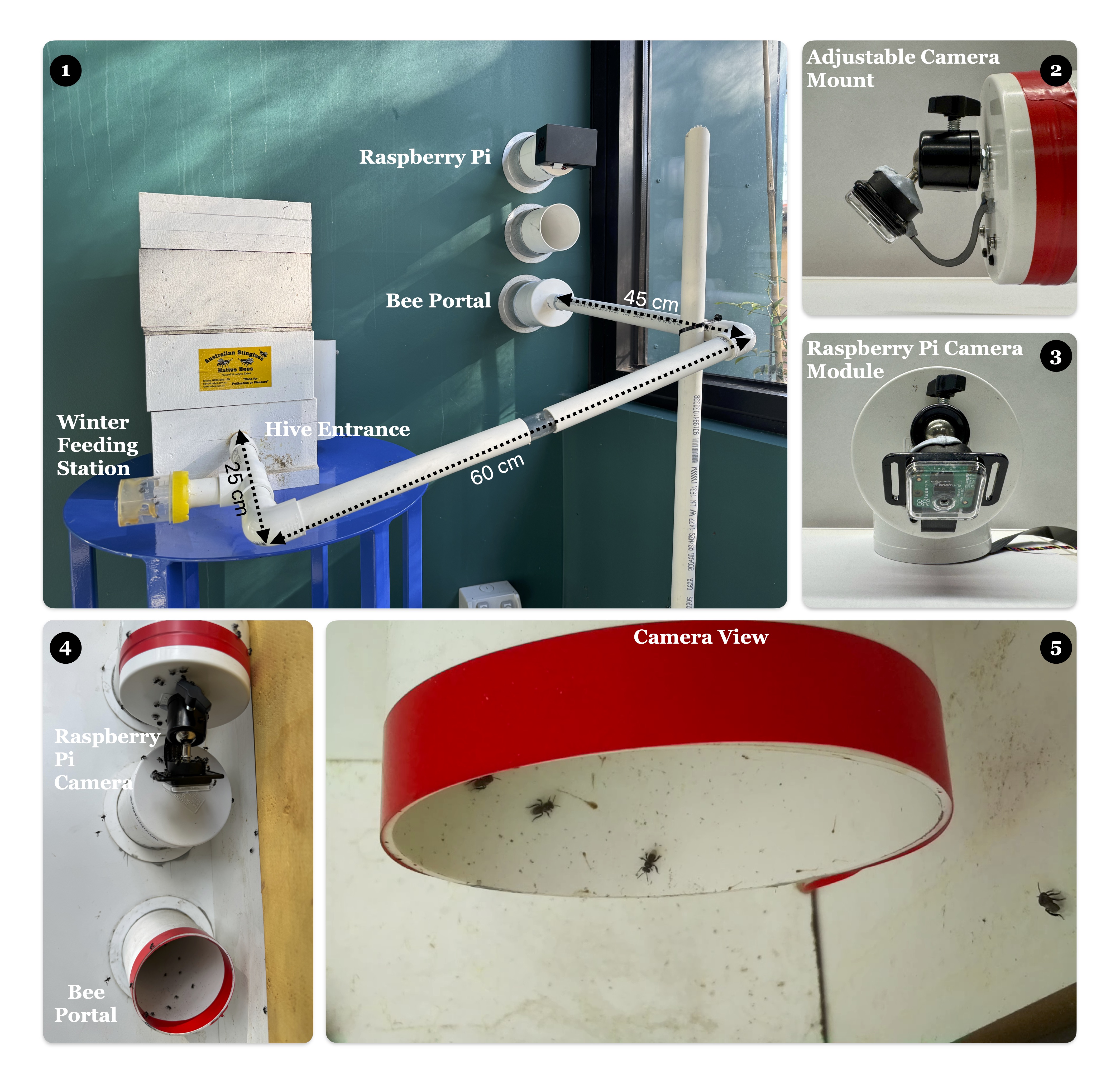Research Areas
AI for Biodiversity Monitoring and Conservation

My research applies artificial intelligence to monitor biodiversity, focusing on automating the detection and tracking of pollinators, particularly native bees. The goal is to develop scalable AI-driven systems that provide ecologists with insights into pollinator behaviour and environmental health. In this research, I am utilising computer vision and to detect bees and multiple object tracking to track these bees. In association with recorded environmental data such as temperature, light intensity, wind speed, and rainfall, we aim to correlate bee foraging behaviour and environmental indicators, thus offering automated approaches to better understand native social and solitary bees and their impact on the terrestrial biodiversity.
Re-Identification for Markerless Individual Bee Identification
Insect re-identification is the ability to identify the same individual insect over spatial and temporal distances. Re-Identification allows researchers to track individual insect behaviour over long monitoring periods even if there are periods when the insect is unobservable. This monitoring may therefore potentially cover a substantial part of the insects' life time. In this research, we have presented a markerless visual re-identification approach based on a FaceNet deep learning face recognition model. We applied our re-identification approach to count individual Exoneura robusta bees in a simulated time-lapse bee monitoring setup and showed that our approach improves the accuracy of bee counting compared to a naïve approach. Accurate counting via recognition of individual insects from insect monitoring videos has the potential to allow us to estimate species abundance of the monitored area. This is crucial in accurate assessment of biodiversity and pollination activity.
AI for Medical Imaging: Ultrasound Bone Segmentation
My research in medical image segmentation focuses on developing deep learning models for accurate and efficient segmentation of medical images. I have worked on developing models for segmenting ultrasound images of bone cysts, which are crucial for osteolytic bone tumor surgery. The goal is to develop a real-time, radiation-free system that can assist surgeons in localizing cystic bone lesions accurately during surgery.
The generative approach we used in our work is based on Pix2Pix image-to-image translation network. We have proposed a multiple-snapshot approach, which mitigates the uni-modal deterministic output issue in the Pix2Pix network without using any complex architecture and training process. We also identified standard data augmentation approaches necessary for ultrasound bone surface segmentation through experiments.
We have evaluated our networks using 800 ultrasound images from trained regions (humerus bone) and 1200 ultrasound images from untrained regions (tibia and femur bones) using four different augmentation approaches. The results show that the generative augmentation approach has a positive impact on accuracy in both trained (+ 4.88%) and untrained regions (+ 25.84%) compared to using only standard augmentations. Moreover, compared to standard augmentation approaches, the addition of the generative augmentation approach also showed a similar trend in both trained (+ 8.74%) and untrained (+ 11.55%) regions.
Generative approaches are very beneficial for data augmentation, where limited dataset size is prevalent, such as ultrasound bone segmentation. The proposed multiple-snapshot Pix2Pix approach has the potential to generate multimodal images, which enlarges the dataset considerably.
AI for Medical Imaging: 2D-3D Registration using Particle Swarm Optimisation
In medical imaging, 2D-3D registration is a crucial step for image-guided interventions. It involves aligning preoperative 3D images with intraoperative 2D images to provide real-time guidance to surgeons. The accuracy of 2D-3D registration is critical for the success of the surgery. However, the non-linear and non-convex nature of the optimization problem makes it challenging to achieve high accuracy, especially when the initial alignment is far from the optimal solution. Gradient-based optimization algorithms are commonly used for 2D-3D registration, but they are sensitive to the initial alignment and prone to getting stuck in local minima. Population-based optimization algorithms, such as particle swarm optimization (PSO), are more robust to local minima and can provide better accuracy and convergence rates for 2D-3D registration.
Population-based optimization algorithms have proved themselves very effective and efficient way for solving some complex problems, particularly for problems of non-linear and non-convex nature. 2D-3D registration is one such problem where inherent non-linearity and high-dimensionality along with non-convex optimization nature makes it very difficult to achieve satisfying accuracy especially when starting point for optimization is not ideal. Because of the underlying structure of population-based optimization algorithms, especially particle swarm optimization (PSO), 2D-3D registration with PSO is expected to yield better accuracy compared to conventional gradient-based optimization algorithms. Another considerable factor is that gradient approximation error makes non-gradient methods more favorable for the case of 2D-3D registration over gradient-based methods. Our experiment on 2D-3D registration using virtual X-ray shows that PSO has better accuracy and convergence rate than gradient based approaches like Stochastic Gradient Descent (SGD), Momentum Stochastic Gradient Descent (MSGD) and Nesterov Accelerated Gradient (NAG).